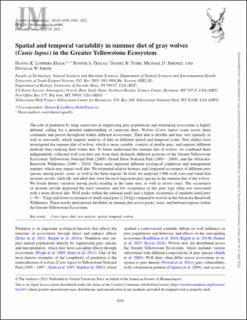| dc.contributor.author | Lodberg-Holm, Hanna Kavli | |
| dc.contributor.author | Teglas, Bonnie S. | |
| dc.contributor.author | Tyers, Daniel B. | |
| dc.contributor.author | Jimenez, Michael D. | |
| dc.contributor.author | Smith, Douglas W. | |
| dc.date.accessioned | 2022-04-21T07:43:03Z | |
| dc.date.available | 2022-04-21T07:43:03Z | |
| dc.date.created | 2022-01-28T09:45:10Z | |
| dc.date.issued | 2021 | |
| dc.identifier.citation | Lodberg-Holm, H. K., Teglas, B. S., Tyers, D. B., Jimenez, M. D. & Smith, D. W. (2021). Spatial and temporal variability in summer diet of gray wolves (Canis lupus) in the Greater Yellowstone Ecosystem. Journal of Mammalogy, 102(4), 1030-1041. | en_US |
| dc.identifier.issn | 0022-2372 | |
| dc.identifier.uri | https://hdl.handle.net/11250/2991816 | |
| dc.description.abstract | The role of predation by large carnivores in suppressing prey populations and structuring ecosystems is highly debated, calling for a detailed understanding of carnivore diets. Wolves (Canis lupus) roam across three continents and persist throughout widely different ecosystems. Their diet is flexible and may vary spatially as well as seasonally, which requires analysis of diet on different spatial and temporal scales. Few studies have investigated the summer diet of wolves, which is more variable, consists of smaller prey, and requires different methods than studying their winter diet. To better understand the summer diet of wolves, we combined three independently collected wolf scat data sets from three distinctly different portions of the Greater Yellowstone Ecosystem: Yellowstone National Park (2009), Grand Teton National Park (2003 – 2009), and the Absaroka-Beartooth Wilderness (2009 – 2010). These areas represent different ecological conditions and management regimes, which may impact wolf diet. We estimated relative biomass and compared occurrence of different prey species among packs, years, as well as the three regions. In total, we analyzed 1,906 wolf scats and found that neonate cervids, adult elk, and adult deer were the most important prey species in the summer diet of the wolves. We found dietary variation among packs residing in the same area, as well as across years. The occurrence of neonate cervids displayed the most variation, and low occurrence of this prey type often was associated with a more diverse diet. Wolf packs within the national parks had a higher occurrence of medium-sized prey (~ 50 – 70 kg) and lower occurrence of small-sized prey (≤ 20 kg) compared to wolves in the Absaroka-Beartooth Wilderness. These results demonstrate flexibility in summer diet across packs, years, and between regions within the Greater Yellowstone Ecosystem. | en_US |
| dc.language.iso | eng | en_US |
| dc.rights | Navngivelse 4.0 Internasjonal | * |
| dc.rights.uri | http://creativecommons.org/licenses/by/4.0/deed.no | * |
| dc.title | Spatial and temporal variability in summer diet of gray wolves (Canis lupus) in the Greater Yellowstone Ecosystem | en_US |
| dc.type | Peer reviewed | en_US |
| dc.type | Journal article | en_US |
| dc.description.version | publishedVersion | en_US |
| dc.rights.holder | © The Author(s) 2021. | en_US |
| dc.source.pagenumber | 1030-1041 | en_US |
| dc.source.volume | 102 | en_US |
| dc.source.journal | Journal of Mammalogy | en_US |
| dc.source.issue | 4 | en_US |
| dc.identifier.doi | https://doi.org/10.1093/jmammal/gyab060 | |
| dc.identifier.cristin | 1992029 | |
| cristin.ispublished | true | |
| cristin.fulltext | postprint | |
| cristin.qualitycode | 1 | |

